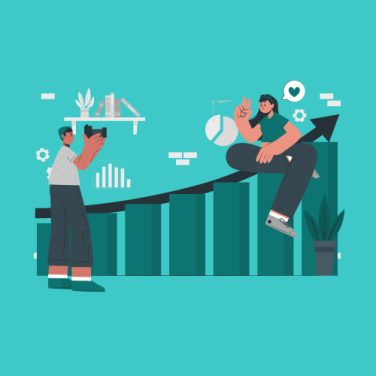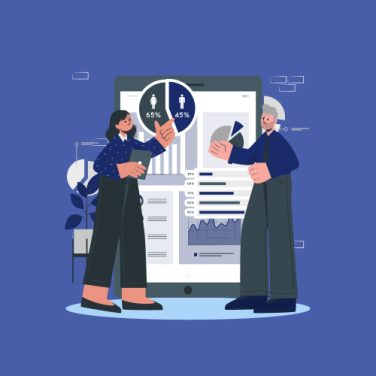Employee Lifecycle Management (ELM) represents a strategic shift from siloed HR processes to an integrated, end-to-end talent journey framework.
By managing every phase of an employee’s tenure from attraction and recruitment through onboarding, engagement, development, retention, and exit, organisations unlock improved productivity, cost savings, and stronger employer branding.
In contrast to traditional, process-driven HR models, ELM offers a unified approach that aligns talent initiatives with business goals, ensuring consistent experiences at each touchpoint.
With data-driven HR decisions enabled by advanced analytics and AI, HR teams gain predictive insights into turnover risks, engagement drivers, and development needs. This strategic alignment results in enhanced employee engagement, reduced time to productivity, and optimised retention rates.
Modern tools such as MiHCM Data & AI integrate seamlessly with lifecycle stages, empowering HR professionals with real-time dashboards, KPI tracking, and actionable alerts.
This guide explores how AI and analytics reshape employee lifecycle management, highlights strategic benefits, and previews MiHCM’s modular suite for full-spectrum ELM optimisation. Readers will gain a clear roadmap for transitioning from traditional HR silos to a unified, analytics-driven approach that drives measurable results.
Quick takeaways
- Employee lifecycle management spans recruitment, onboarding, engagement, development, retention, and alumni engagement.
- Data-driven KPIs and predictive analytics unlock insights into turnover risks and performance drivers.
- Customisable templates and RACI charts accelerate framework development and governance.
- MiHCM’s suite aligns features to each lifecycle stage: Talent Acquisition & Onboarding, Employee Self-Service, SmartAssist, and MiHCM Data & AI.
What is Employee Lifecycle Management?
Employee Lifecycle Management (ELM) is the holistic coordination of HR activities and programmes that guide individuals through every phase of their journey with an organisation. It covers:
- Attraction: Employer branding, targeted outreach, and candidate experience.
- Onboarding: Preboarding checklists, orientation, and capability ramp-up.
- Development: Training programmes, coaching, and career pathing.
- Engagement: Pulse surveys, recognition programmes, and wellbeing initiatives.
- Retention: Stay interviews, inclusion efforts, and compensation benchmarking.
- Exit & Alumni: Offboarding interviews, knowledge transfer, and alumni networks.
By integrating these phases under a single framework, ELM ensures consistent experiences and strategic alignment with business objectives. It shifts HR from transactional operations to a proactive, experience-centric discipline.
Evolution of ELM in HR
Historically, HR managed discrete functions: recruiting, training, and benefits. Siloed processes often led to gaps in candidate experience, onboarding delays, and reactive retention efforts. Today:
- Advanced HRIS platforms consolidate data for real-time visibility.
- Predictive analytics identify flight risks and skill gaps before they surface.
- Experience-centric design draws from marketing best practices to enhance employer brand and internal culture.
As a result, organisations that adopt ELM see improvements in time-to-fill, ramp-up metrics, engagement scores, and voluntary turnover, supporting a culture of continuous improvement and strategic talent management.
Why effective employee lifecycle management matters
Effective employee lifecycle management drives measurable business impact:
- Retention costs: Reduces average turnover costs (recruitment, lost productivity) by up to 30% through proactive risk detection and engagement initiatives.
- Productivity gains: Accelerates new-hire productivity by 20% via structured onboarding and AI-driven learning paths.
- Employer branding: Strengthens reputation with candidates and customers by delivering seamless experiences across touchpoints.
Additionally, ELM supports regulatory compliance by maintaining audit trails for hiring, training, and offboarding, mitigating legal risks. A positive employee experience fosters brand advocacy; employees are more likely to refer candidates and serve as public-facing ambassadors.
Analytics plays a crucial role in proactive talent risk management. By tracking engagement scores, performance trends, and development milestones, HR teams can anticipate attrition hotspots, skills shortages, and diversity gaps.
This data-driven approach ensures that interventions are timely and targeted, reinforcing a culture of continuous feedback and improvement.
Stages of the employee lifecycle
- Attraction & Recruitment
- Objective: Build an engaged talent pipeline that aligns with employer brand and culture.
- Key metrics: Time-to-fill, quality-of-hire, candidate satisfaction scores.
- Best practices: Use targeted social media campaigns, inclusive job descriptions, and an ATS integrated with MiHCM Enterprise or MiHCM Lite for streamlined workflows.
- Onboarding
- Objective: Ensure new hires become productive and feel supported from day one.
- Key metrics: Time-to-productivity, onboarding satisfaction, training completion rates.
- Best practices: Deploy digital onboarding via MiA, structured checklists, peer buddy programmes, and check-in reminders for managers. See our guide on optimising employee onboarding for maximum engagement.
- Engagement
- Objective: Maintain high motivation, satisfaction, and alignment with organisational values.
- Key metrics: Pulse survey scores, participation rates, internal Net Promoter Score (eNPS).
- Best practices: Implement SmartAssist for regular pulse surveys, social recognition, and wellbeing check-ins.
- Development
- Objective: Cultivate skills and career paths to meet evolving business needs.
- Key metrics: Training hours logged, competency attainment, internal mobility rates.
- Best practices: Leverage Employee Self-Service for personalised learning, AI-driven skill gap analysis, and mentorship programs.
- Retention
- Objective: Sustain high performers and reduce voluntary turnover.
- Key metrics: Turnover rate, stay interview feedback, burnout indicators.
- Best practices: Offer competitive compensation, flexible work policies, and inclusion initiatives supported by MiHCM Data & AI for predictive alerts.
- Exit & Alumni
- Objective: Facilitate dignified exits and cultivate alumni as brand advocates.
- Key metrics: Offboarding completion, exit interview insights, alumni engagement rates.
- Best practices: Automate offboarding workflows, conduct transparent exit interviews, and maintain an alumni portal integrated with MiHCM.
Developing an effective employee lifecycle management framework
To build a robust ELM framework, follow these steps:
- Assess current state: Audit existing processes, stakeholder roles, data sources, and technology.
- Design target framework: Map desired lifecycle stages with clear objectives, activities, and metrics. Use RACI charts to assign ownership across HR, managers, and employees.
- Implement technology: Deploy MiHCM modules Talent Acquisition & Onboarding, Employee Self-Service, SmartAssist, and Data & AI to automate workflows and centralise data.
- Measure performance: Define KPIs for each stage (e.g., time-to-fill, eNPS, turnover prediction accuracy) and set SMART targets.
- Iterate continuously: Use dashboards and predictive analytics to identify friction points, update processes, and refine interventions.
Governance and ownership
Establish a cross-departmental steering team with representatives from HR, IT, finance, and business units.
This governance model ensures clear accountability, data integrity, and alignment with strategic objectives.
Regular reviews and a shared dashboard foster transparency and support continuous improvement across the employee lifecycle management framework.
Leveraging MiHCM to optimise each lifecycle stage
MiHCM’s modular HRIS suite aligns with every phase of the employee lifecycle management process:
- Attraction & Recruitment: MiHCM Enterprise and MiHCM Lite enable job posting automation, ATS integration, and branded career portals for seamless candidate experiences.
- Onboarding: MiA-driven digital onboarding and compliance checklists streamline document collection and orientation tasks, reducing paperwork by 50%.
- Engagement & Development: Employee Self-Service offers mobile access to training resources and performance goals, while SmartAssist delivers pulse surveys, social recognition, and scheduling for coaching sessions.
- Retention & Analytics: MiHCM Data & AI provides predictive dashboards for turnover risk, workforce demographics, and cost-of-labour analysis enabling data-driven HR decisions.
- Exit & Alumni: Automated offboarding workflows ensure compliance, while the alumni portal maintains network engagement and potential boomerang hires.
Key benefits include:
- Streamlined HR operations through automated workflows.
- Enhanced employee engagement via personalised self-service and recognition.
- Turnover management with predictive alerts and targeted interventions.
- Data-driven HR decisions supported by real-time analytics and KPIs dashboards.
Employee lifecycle management templates and examples
| Phase | Activities | Stakeholders |
|---|---|---|
| Attraction & Recruitment | Employer branding, job posting, screening | Talent Acquisition, Marketing |
| Onboarding | Preboarding, orientation, buddy program | HR, Hiring Manager |
| Engagement | Pulse surveys, recognition, wellbeing | HR, Team Leads |
| Development | Training, mentoring, career planning | Learning & Development |
| Retention | Stay interviews, flexible policies, rewards | HR, Managers |
| Exit & Alumni | Offboarding, exit interviews, alumni events | HR, Alumni Relations |
Next steps
Employee lifecycle management empowers organisations to align talent initiatives with strategic goals, driving retention, engagement, and productivity.
A structured ELM framework, supported by clear KPIs and governance, delivers measurable benefits—from reduced time-to-fill to enhanced employer brand advocacy.
- Explore MiHCM modules tailored to each lifecycle phase for seamless integration and automation.
- Leverage our ultimate guide to HR digital transformation to accelerate your journey.
Next steps involve conducting a current-state assessment, setting SMART targets, and deploying MiHCM Data & AI for predictive insights.
Begin your employee lifecycle optimisation today to secure long-term talent success.



